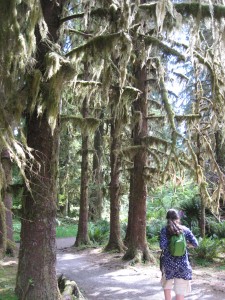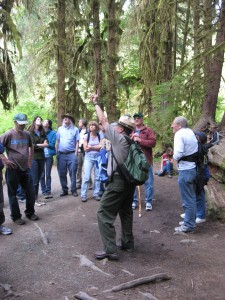As you walk through evergreens shrouded in club moss and witness elk munching on the low-lying branches of century-old trees, the Hoh Rainforest may feel otherworldly. Avatar or Tolkien’s Middle Earth come to mind. Within the diverse patchwork of Olympic National Park’s ecosystems, the Hoh Rainforest is recognized as a Biosphere Reserve and World Heritage site. Annual precipitation ranges from 140 to 167 inches. The competitive environment is abundant with epiphytes, multi-layered canopies, and undergrowth that ensures the covering of every square inch with vegetation (with the exception of human trampling evidenced by the picture above).
On our way into the park we spotted a wilk herd of Roosevelt Elk.
I was previously unaware of the nurse log phenomenon. As a fallen log in the Hoh decays over a span of up to 300 years, the weight of living organic matter actually increases with time. Seedlings vie for space on the log, their roots grow around the log, and a row of trees results, as if planted by humans. In the image above, for instance, three sitka spruce are perched on the remains of a nurse log. Eventually, when the nurse log completely decays, a colonnade of trees will remain.
We attended a guided hike led by a ranger knowledgeable of every species we spotted. Prevalent tree species include Sitka Spruce, Western Hemlock, Western Red Cedar, Douglas Fir, Big Leaf Maple, and Vine Maple.






Sitka spruce is in the big leagues as far as trees are concerned along with other west coast giants like Douglas-fir and western red cedar. Sitka spruce is the largest of the spruce species with strongly out-thrust limbs and a fringe of drooping branches.